The Larval Project developed over 2 years and many stages since inception: including original mask design and fabrication, community training, ensemble development, original work devising and performance.
MASK CREATION:
The Larval masks used by LARVAL PROJECT were designed throughout the year of 2011 and fabricated in November 2011 by Tara Cariaso, the Artist Director of Waxing Moon Masks. Four distinct masks were created, all four forms were fabricated in both neoprene and paper mache and prepared for actors to wear. The four shapes each offer unique geometric curves, planes and angles to challenge and aid to actor to physically inhabit the body of the mask.
In January of 2011, Tara hosted the first Larval Mask Workshop to introduce Baltimore performers to this style of mask and it's unique play on stage. This workshop was also important in developing the identity and play of the masks.
ENSEMBLE TRAINING AND DEVISING IN MASK:
Due to active interest to continue the larval mask work, WMM began a 4 month training program in April of 2012 and invited the Baltimore community to participate in the training. The training was free of charge, save the expenses to sublet a performance space, which was an expense the group shared. This group, known as the the Larval Project Ensemble, met every Friday April through July, training in ensemble theatre techniques, mask performance, devising, story writing, puppetry and gesture/mime. We had our own resident Foley artist/musician who created original improvised soundscapes with a number of instruments and objects.
The work was a collaboration between actors, directors and musicians. Registration and participation in this ensemble work remained open throughout it's existence to encourage more people to participate and get exposure to this work.
The project was an experiment in ensemble decision making and devising for the stage in these masks. As a result of the work of this workshop process, there exists a great depth of knowledge among the ensemble members about these masks, how they work, play, and read to an audience, what stories they tell and how they relate to an audience.
MASK PERFORMANCE:
The workshop period of the project ended in July of 2012, and two members, Tara Cariaso and Chris Yeiser, continued to devise in these masks, honing story and style to cultivate a unique "Larval Culture of Play" and storytelling for these masks.
In September of 2012, Yeiser and Cariaso performed two short works, about 10 minutes each, showcasing their work in Larval Masks at the 2012 Baltimore Book Festival on the Pearl Stage at Centerstage, as a part of "50FEST". The piece performed featured 2 full face larval masks, found object puppetry, and mime, and was received with great enthusiasm by the 50FEST audience.
MASK CREATION:
The Larval masks used by LARVAL PROJECT were designed throughout the year of 2011 and fabricated in November 2011 by Tara Cariaso, the Artist Director of Waxing Moon Masks. Four distinct masks were created, all four forms were fabricated in both neoprene and paper mache and prepared for actors to wear. The four shapes each offer unique geometric curves, planes and angles to challenge and aid to actor to physically inhabit the body of the mask.
In January of 2011, Tara hosted the first Larval Mask Workshop to introduce Baltimore performers to this style of mask and it's unique play on stage. This workshop was also important in developing the identity and play of the masks.
ENSEMBLE TRAINING AND DEVISING IN MASK:
Due to active interest to continue the larval mask work, WMM began a 4 month training program in April of 2012 and invited the Baltimore community to participate in the training. The training was free of charge, save the expenses to sublet a performance space, which was an expense the group shared. This group, known as the the Larval Project Ensemble, met every Friday April through July, training in ensemble theatre techniques, mask performance, devising, story writing, puppetry and gesture/mime. We had our own resident Foley artist/musician who created original improvised soundscapes with a number of instruments and objects.
The work was a collaboration between actors, directors and musicians. Registration and participation in this ensemble work remained open throughout it's existence to encourage more people to participate and get exposure to this work.
The project was an experiment in ensemble decision making and devising for the stage in these masks. As a result of the work of this workshop process, there exists a great depth of knowledge among the ensemble members about these masks, how they work, play, and read to an audience, what stories they tell and how they relate to an audience.
MASK PERFORMANCE:
The workshop period of the project ended in July of 2012, and two members, Tara Cariaso and Chris Yeiser, continued to devise in these masks, honing story and style to cultivate a unique "Larval Culture of Play" and storytelling for these masks.
In September of 2012, Yeiser and Cariaso performed two short works, about 10 minutes each, showcasing their work in Larval Masks at the 2012 Baltimore Book Festival on the Pearl Stage at Centerstage, as a part of "50FEST". The piece performed featured 2 full face larval masks, found object puppetry, and mime, and was received with great enthusiasm by the 50FEST audience.
-
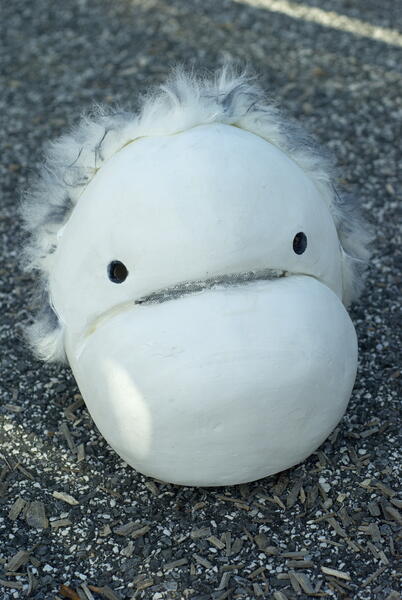 Larval mask 4This mask has a strong presence, though he may not always know what he wants.
Larval mask 4This mask has a strong presence, though he may not always know what he wants. -
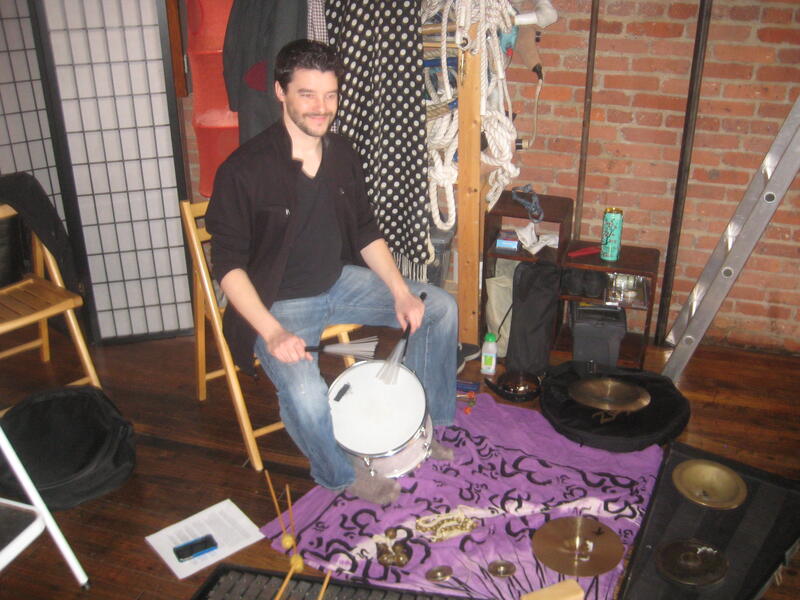 Live Foley MusicianOur Live Foley musician and sound scape expert, Mike Castor improvises with the actors, bringing size and greater timing to their mask research.
Live Foley MusicianOur Live Foley musician and sound scape expert, Mike Castor improvises with the actors, bringing size and greater timing to their mask research. -
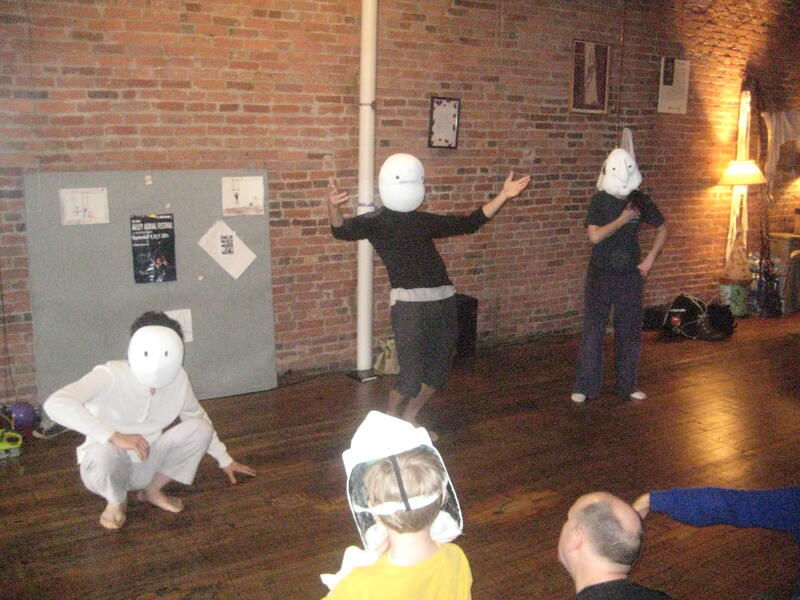 img_5685.jpg
img_5685.jpg -
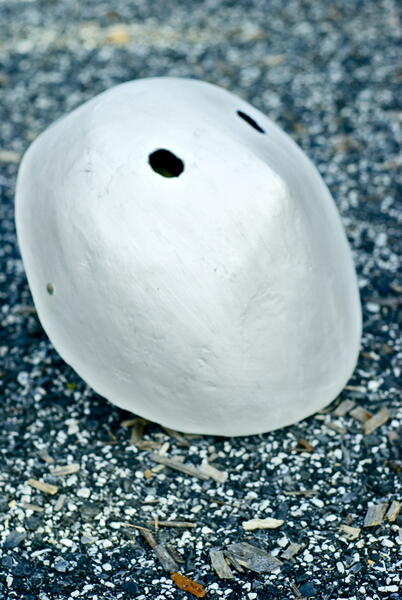 Larval mask 3Ever the naive, this mask can't help but wander out of bounds time and time again.
Larval mask 3Ever the naive, this mask can't help but wander out of bounds time and time again. -
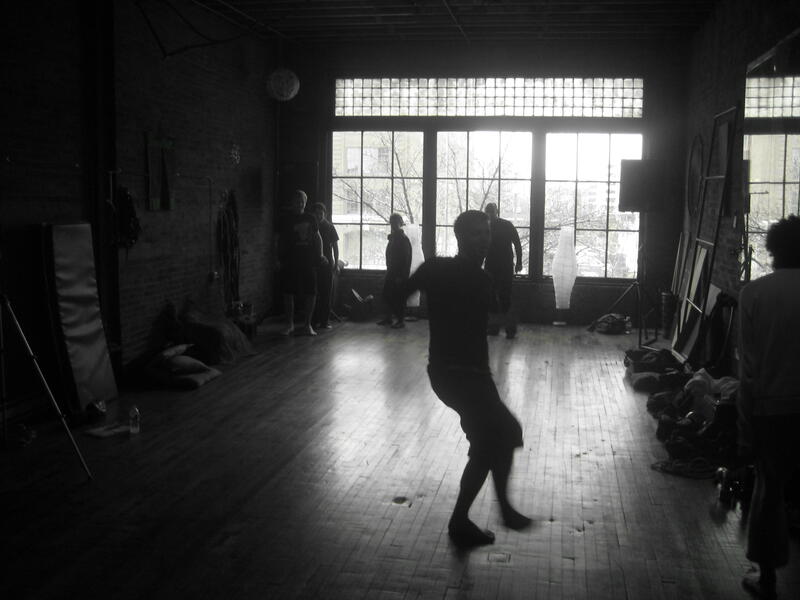 Initial Larval Workshop, movementThis image features the 7 participants in the 2 day weekend workshop series in Larval Masks, January 2012. Expanding the actor's movement vocabulary is the foundation of all mask exploration. Here you see actors crossing the space with individual rhythms. Taken in the In-Flight Theatre studio space at Load of Fun.
Initial Larval Workshop, movementThis image features the 7 participants in the 2 day weekend workshop series in Larval Masks, January 2012. Expanding the actor's movement vocabulary is the foundation of all mask exploration. Here you see actors crossing the space with individual rhythms. Taken in the In-Flight Theatre studio space at Load of Fun. -
The WeightliftersBrilliant short improvisation between two larval masks inhabited by characters with very different bodies. Performed by ensemble researchers, Brian Francoise and Jeff Tremper.
-
Description of Larval Masks and their useThe Larval mask lives in a realm of highly stylized theatre performance, a realm which ignites an audience’s imagination and provides moments of discovery, surprise and delight. For the actor, the masks inspire a child-like glee in the quality of play and provide essential tools for communicating character through the body.
-
 Larval mask 2An invention of both sharp points and curves, this mask finds himself lost quite often it seems.
Larval mask 2An invention of both sharp points and curves, this mask finds himself lost quite often it seems. -
 Larval maskLong nosed and always curious, this larval mask is always going somewhere specific.
Larval maskLong nosed and always curious, this larval mask is always going somewhere specific. -
Alternate Uses of a Larval MaskThe mask is generally worn on a head, it's true. But mask is a very close cousin to PUPPETRY. These short video clips share with you some of the research done in examining how these specific masks might be used to create eccentric characters and unexpected stories without being worn on the face. Some of my favorite images of mask work come from these explorations, and I hope you are as provoked into curiousity as I am upon watching them.








